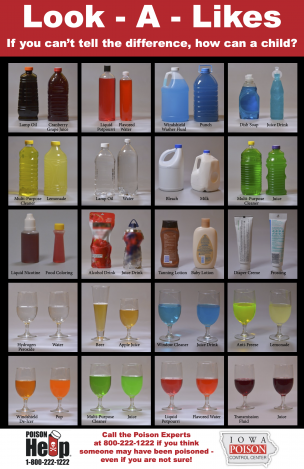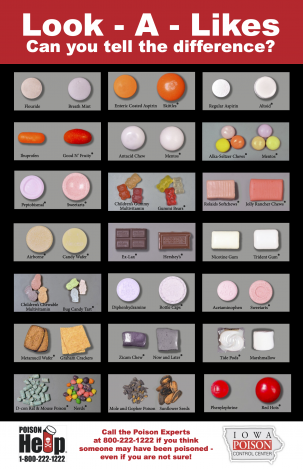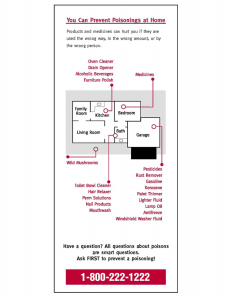Poison Prevention Week – 2021
Poison Prevention Week 2021
Waukee Elementary School Nurse Kim Hunt outlines safety tips and prevention practices for the Waukee Community School District.
What is a poison?
Poisons are anything that can harm you when exposed, and they are all around us. People can be exposed to poisons in 4 different ways:
- Ingestion – Eating/swallowing.
2. Inhaling – Hazardous gases, harmful fumes from chemicals, or burning products emitting harmful fumes.
3) Skin contact – Corrosive products can cause burns or tissue damage. Issues including systemic toxicity can arise if some products are absorbed into the skin. This can include overuse of otherwise safe topical products such as antihistamine ointments, hand sanitizers, etc.
4) Spraying – Sprays into the face/eyes (mucous membrane contact).
Scary Fact
Deaths from accidental poisonings have doubled since the 1990’s.
Preventing Accidental Poisonings
- Keeping hazardous chemicals, laundry, and cleaning, and auto products in a cabinet that is locked or equipped with safety latches, and/or storing them out of reach of children. This includes lawn chemicals, insecticides, and vehicle fluids such as anti-freeze, windshield washer fluid, and oil. Safely discard old or unused chemicals and containers.
- Of note, pod type dishwasher and laundry detergents are very toxic. Take special care to store those properly, or consider using liquid or powder instead if you have children under 6 years old.
- Keeping medications and ointments out of reach of children and/or in a secure cabinet, as well as the back-up of the child resistant packaging that much of our medication comes in. Don’t ever tell your child medicine is “candy” to encourage them to take something. (Dispose of unused, unneeded, or expired medication properly.)
- Storing all chemicals and food items completely separate from each other to alleviate potential confusion between products or exposure by food items to chemicals.
- Teaching our family members about the dangers of poisons and improper use of medications. Medications are intended for specific uses in specific doses by individuals with specific health issues. Any type of medication can be very harmful if taken by the wrong person or in the wrong dose.
- Teaching our family members the importance of knowing exactly what they are eating or drinking. Train children to check with an adult before tasting or drinking anything new or different looking. An alcoholic beverage may look like a soda can and taste good to a child, but would be toxic to them. Food extracts like vanilla and almond smell good, but have high alcohol content and could harm them. Mouthwash smells good and may taste pleasant, but is harmful if swallowed.
- It is really easy for children to confuse poisons with something safe. Medicine can taste or look like candy, cleaning products or other chemicals can look like fruit juices or sports drinks. Many products smell good, but shouldn’t be eaten.
Other Prevention Tips
- Try to keep products in their original containers with labels intact. This will increase the likelihood that the packaging is child resistant, and also just make it very obvious what substance is in the container if there is ever any concern. Also, product labels will have instructions for proper use to prevent poisoning, as well as specific information about what you should do if the product comes into contact with skin, eyes, or is ingested.
- Always close containers fully, so that the child resistant caps can do their jobs. If nothing else, the time it would take to open the container will hopefully provide a grace period for you to catch that your child has something that they shouldn’t!
- Never set open containers of medicine or other chemicals down to take a phone call or answer the door if there are children, or even pets, around. Try to always use and then close properly and put them away safely!
- Try to keep household plants out of the reach of children, as some can be toxic, or fertilizers or plant foods helpful to your plants are toxic to humans.
- Never mix household products together, some reactions caused by mixing these chemicals can lead to hazardous fumes being produced, or other harmful results.
Poison Proof Your Home
- Use chemicals only in well-ventilated areas. Open windows or turn on fans if you are using chemicals indoors.
- Wear protective goggles when using chemicals that might splash in your face. Wear appropriate clothing if you are spraying pesticides or other chemicals. Keep children out of lawns that have been recently treated, as pesticides can absorb through the skin.
- Some less obvious potential hazards include the contents of purses and diaper bags. I know, even now as a mom of teenagers on up, my purse ends up being a traveling medicine cabinet, with everything from pain relievers, cold and allergy medicine, antibiotic ointment, and epi-pens! Right now, many of us also carry hand sanitizer, which contains high levels of alcohol that are very toxic in even small amounts if ingested, or if a large amount is used or spilled on a small child and absorbed through the skin at one time. Our makeup, perfumes, and hair and nail products can even be harmful if not used correctly or if swallowed. If you can, keep your purse zipped/closed and have a separate zipped or secure storage area for all medications. Also, if you are at someone else’s house where kids might find your purse tempting, try to keep it closed, and up out of reach of curious little ones.
- If you use e-cigarettes, keep the liquid nicotine refills locked up out of children’s reach and only buy refills that use child-resistant packaging. A small amount of liquid nicotine spilled on the skin or swallowed can be fatal to a child.
- Monitor and secure the battery compartments of remote controls, key fobs, musical greeting cards and books, that might contain button cell batteries. These can cause serious injury in a very short amount of time if ingested.
- A poison we don’t think about as much is carbon monoxide. Each household should have at least 1 functioning carbon monoxide alarm, preferably located near the sleeping area(s) of the home.
WHAT TO DO IF AN ACCIDENTAL POISONING OCCURS
- For any poisoning situation, if the victim has collapsed or stopped breathing, call 911 immediately! If you or someone else present knows CPR, initiate CPR and continue until the victim revives or someone else arrives to take over.
For conscious victims, the following treatment is advised in these situations:
- Swallowed poison—Take the item away from the person, and have them spit out any remaining substance. Have them rinse their mouth out thoroughly (swish water around and spit out). DO NOT make the person vomit. CALL POISON CONTROL.
- Swallowed battery—if your child has swallowed a button-cell battery or has a battery lodged in his/her nose, ear, or throat, GO TO A HOSPITAL EMERGENCY DEPARTMENT IMMEDIATELY. Serious tissue damage can occur in as little as 2 hours.
- Skin poison—Remove the victim’s clothes and rinse the skin with lukewarm water for at least 15 minutes.
- Eye poison—Flush the victim’s eye(s) by holding the eyelid open and pouring a steady stream of room temperature water into the inner corner for 15 minutes.
- Poisonous fumes—Get the person outside or into fresh air immediately.
Some people who have been poisoned may not look, feel, or act sick right away. Even if the person feels fine, call the poison center!
When you call poison control, try to have the following information if possible:
- Victim’s approximate age and weight.
2) Container or bottle of poison, if possible.
3) Time of the poison exposure.
4) The address of the location the poisoning occurred.
**Always remember, everything can be a poison if not taken or used appropriately! I hope this information will be useful for you to keep your loved ones safe!
Poison Control Information
Call – 1-800-222-1222
Visit – www.poison.org or iowapoison.org




